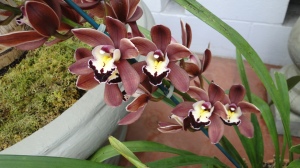Native to tropical Asia or Australia, these semi-terrestrial orchids grow with swollen stems resembling bulbs
(termed pseudobulbs). Flowers, all but pure red or blue, emerge from a spike bearing possibly twenty (but commonly fewer)
Cymbidium (Orchid)
Family: Orchidaceae
Subspecies: countless cultivated/subspecies/varieties/hybrids (Dear Eillen ‘Delight’, Dilly ‘Dei Mar’, Evening ‘Bethlehem’, Maluka ‘Brilliant’, Mimi ‘Mary Bae’, Mini Torch ‘Red Beacon’, Red Back ‘Solid Gold’, Sarah Jean, Sylvia Miller ‘Brilliance’, Valley Blush ‘Magnificient’, Via Verde Dean, Mouchette ‘Magic Mushroom’, to name a few)
Native: tropical Asia, Australia
Hardiness Zones: 10-12
Height: leaves to roughly 40 centimeters, flowers to almost 120 centimeters on non-miniatures
Diameter: to about 60 centimeters
Root System: easily susceptible to rot, to 12cm long, to nearly 1cm thick, sometimes autotrophic
(photosynthetic)/mycotrophic/glabrous
Growth Rate: rapid
Age: perennial
Deciduous: usually not
Monoecious/dioecious: monoecious
Monocot/dicot: dicot
Tolerates: relatively fragile
Problems (major): root/stem rot (collar rot, black rot), bar mottle, diamond mottle, ringspot virus
Problems (minor): aphids, spider mites, mealybug, scale, flower spotting, mosaic virus, leaf scorch (too
warm/excessive sun)
Poisonous: contains quinones (toxic if ingested), possible very minor dermatitis for select individuals
Soil requirements: a natural epiphyte, prefers very well-drained soil (typically redwood bark chips or
perlite), appreciates balanced 20-20-20 fertilizer or 30-10-10 NPK in bark only
Air requirements: requires high humidity, in the 60-80% range
Watering requirement: light watering every few days to keep soil moist (with tepid water) and frequent
misting on LEAVES (not on flowers!)
Sun requirement: requires full sun, partial sun/shade reduces blooms except in excessively warm summers
Leaf size: to 60 centimeters long attached to a petiole-like stem outgrowth
Leaf shape: strap-like, elliptic, arching, typically to 4 attached to thickened stem (ovoid pseudobulb)
Flowering frequency: annually in fall or winter
Flower color(s): any except pure red or blue
Flower gimmick: flower spikes not deceitful
Petals/Sepals: unusually thick tepals, 5 petals to 8 centimeters across
Lip/Column: mouth-like lip, different colored “landing pad”
Stigma/Anthers: inconspicuous, hidden inside the lip/column
Epiphyte: yes but semi-terrestrial
Daytime temperature: around 21 Celsius (70 Fahrenheit), require a 6-8 week cooler period (reduce ~10-15
degrees Fahrenheit during this time)
Nighttime temperature: around 15 Celsius (60 Fahrenheit)
Notable characteristics:
Semi-terrestrial and native to the East, these orchids grow with swollen stems to store water and nutrients.
While there are forty-four officially listed species, countless hybrids have greatly increased the different “types” in this genus.
Uses:
These are common house-grown orchids. The flowers are commonly used in arrangements for their slight
fragrances and showy qualities.
Sources used:
- http://www.ext.colostate.edu/ptlk/1348.html
- http://www.ipm.ucdavis.edu/PMG/r280111011.html
- http://gardens.si.edu/collections-research/docs/orchid-cymbidium.pdf
- http://www.uaex.edu/yard-garden/resource-library/plant-week/cymbidium-orchid-3-16-07.aspx
- http://scholarship.claremont.edu/cgi/viewcontent.cgi?article=1002&context=cgu_etd
- http://www.missouribotanicalgarden.org/PlantFinder/PlantFinderDetails.aspx?kempercode=b624
- http://flora.huh.harvard.edu/china/PDF/PDF25/Cymbidium.pdf
- http://www.gardenguides.com/131356-toxicity-cymbidium-orchids.html
- http://homeguides.sfgate.com/month-should-start-feeding-bloom-fertilizer-cymbidiums-89953.html
- https://www.orchidsbyhausermann.com/care.htm

Valley Blush ‘Magnificient’ pseudobulbs

Vea Verde Dean
I do not own the rights of these images; all credit goes to its original creator(s). They were all taken
during the Orchid festival at the Missouri Botanical Garden.














